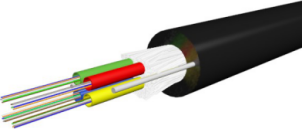 The difference between cables and optical cables is mainly manifested in three aspects. First: There is a difference in material. Second: There is a difference in the transmission signal. Third: There are differences in the scope of application.
The difference between cables and optical cables is mainly manifested in three aspects. First: There is a difference in material. Second: There is a difference in the transmission signal. Third: There are differences in the scope of application.The inside of the cable is copper core wire; the inside of the optical cable is glass fiber. A cable is usually a rope-like cable formed by twisting several or several groups of wires (each group of at least two). The optical cable is a communication line that is composed of a certain number of optical fibers in a certain way and is covered with a sheath, and some are also covered with an outer sheath to realize optical signal transmission.
When the phone converts the acoustic signal into an electrical signal and then transmits it to the switch via the line, the switch transmits the electrical signal directly to another phone via the line for answering. The transmission line during this conversation is a cable.
When the phone converts the acoustic signal into an electrical signal and transmits it to the switch via the line, the switch transmits the electrical signal to the photoelectric conversion device (converts the electrical signal into an optical signal) and transmits it to another photoelectric conversion device via the line (converts the optical signal). The signal is converted into an electrical signal), and then to the switching equipment, to another phone to answer. The line between the two photoelectric conversion devices is an optical cable.
The cable is mainly copper core wire. The core wire diameters are divided into 0.32mm, 0.4mm and 0.5mm. The larger the diameter, the stronger the communication capability; and according to the number of core wires, there are: 5 pairs, 10 pairs, 20 pairs, 50 pairs, 100 pairs, 200 Yeah, wait. Optical cables are only divided by the number of core wires, the number of core wires: 4, 6, 8, 12 pairs and so on.
Cable: It is large in size, weight, and poor in communication ability, so it can only be used for short-range communication. Optical cable: It has the advantages of small size, weight, low cost, large communication capacity, and strong communication capability. Due to many factors, it is currently only used for long-distance and point-to-point (ie, two switch rooms) communication transmission.
Actually, the difference between cables and optical cables is mainly manifested in three aspects.
First: There is a difference in material. Cables use metal materials (mostly copper, aluminum) as conductors; optical cables use glass fibers as conductors.
Second: There is a difference in the transmission signal. The cable transmits electrical signals. Optical cables transmit optical signals.
Third: There are differences in the scope of application. Cables are now mostly used for energy transmission and low-end data information transmission (such as telephone). Optical cables are mostly used for data transmission.
In practical applications, it can be known that optical cables have greater transmission capacity than copper cables. The relay section has a long distance, small size, light weight, and no electromagnetic interference. It has now developed long-distance trunk lines, intra-city relays, offshore and trans - The backbone of ocean submarine communications, as well as wired transmission lines for local area networks, private networks, etc., has begun to develop into the field of user loop distribution networks in the city, providing transmission lines for fiber-to-the-home and broadband integrated service digital networks.
Media Contact
Company Name: Guang Lian
Contact Person: Media Relations
Email: Send Email
Phone: +86 7318 9722704
Country: China
Website: https://www.gl-fiber.com/
